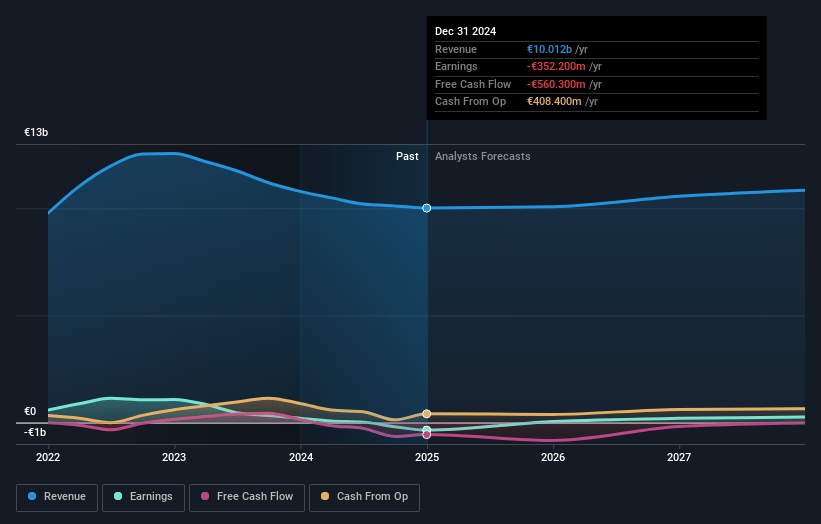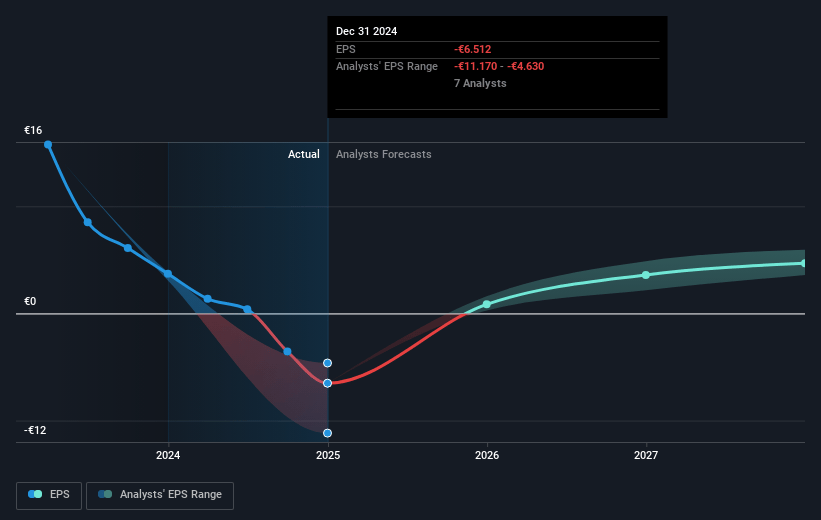Key Takeaways
- EU antidumping measures and green initiatives may boost Salzgitter's revenue through higher steel prices and decarbonization efforts.
- Government infrastructure spending and cost-saving programs could enhance steel demand and improve net margins for Salzgitter.
- Prolonged price pressures, regulatory challenges, and cost volatility threaten Salzgitter's net margins and financial stability amid uncertain market and economic conditions.
Catalysts
About Salzgitter- Engages in steel and technology businesses worldwide.
- The European Union's antidumping measures and safeguards, aimed at protecting the European steel market, could reduce external competition and lead to higher steel prices, potentially increasing Salzgitter's revenue.
- The EU's Steel and Metals Action Plan's focus on reducing energy costs could decrease operational expenses for Salzgitter, thereby improving net margins.
- Increased government investment in infrastructure, especially steel-intensive projects such as roads, energy grids, and defense, could boost demand for Salzgitter's steel products, leading to higher revenues and earnings.
- Salzgitter's involvement in green steel production through the SALCOS program positions it to benefit from the EU's push towards decarbonization and green lead markets, potentially driving revenue growth.
- The performance program P28 aims to achieve significant cost savings, potentially leading to improved net margins and earnings in the coming years.
Salzgitter Future Earnings and Revenue Growth
Assumptions
How have these above catalysts been quantified?- Analysts are assuming Salzgitter's revenue will grow by 2.7% annually over the next 3 years.
- Analysts assume that profit margins will increase from -3.5% today to 2.4% in 3 years time.
- Analysts expect earnings to reach €255.9 million (and earnings per share of €4.68) by about May 2028, up from €-352.2 million today. However, there is a considerable amount of disagreement amongst the analysts with the most bullish expecting €321.9 million in earnings, and the most bearish expecting €194 million.
- In order for the above numbers to justify the analysts price target, the company would need to trade at a PE ratio of 5.9x on those 2028 earnings, up from -3.5x today. This future PE is lower than the current PE for the GB Metals and Mining industry at 18.2x.
- Analysts expect the number of shares outstanding to grow by 0.63% per year for the next 3 years.
- To value all of this in today's terms, we will use a discount rate of 6.26%, as per the Simply Wall St company report.
Salzgitter Future Earnings Per Share Growth
Risks
What could happen that would invalidate this narrative?- The uncertainty around U.S. tariffs and potential shifts in trade policy could lead to market instability, complicating the steel market's revenue forecasting and impacting Salzgitter's ability to maintain stable earnings.
- The European steel market outlook indicates only a gradual recovery without significant pickup expected until 2025, suggesting prolonged pressure on prices and revenues that could impact Salzgitter's financial performance.
- Salzgitter reported a significant net loss before taxes of €296 million in 2024 despite operational improvements, primarily due to onetime effects and write-downs. Continuation of such issues could constrain net margins and overall profitability.
- The volatility in raw materials and energy prices, along with increased grid and electricity costs not fully accounted for, could affect the company’s cost base, potentially compressing net margins and impacting earnings.
- Political and economic pressures related to decarbonization targets and energy transitions could lead to increased operational costs and necessary capital expenditures, straining the company's cash flow and investment capacity.
Valuation
How have all the factors above been brought together to estimate a fair value?- The analysts have a consensus price target of €22.767 for Salzgitter based on their expectations of its future earnings growth, profit margins and other risk factors. However, there is a degree of disagreement amongst analysts, with the most bullish reporting a price target of €45.0, and the most bearish reporting a price target of just €14.5.
- In order for you to agree with the analyst's consensus, you'd need to believe that by 2028, revenues will be €10.8 billion, earnings will come to €255.9 million, and it would be trading on a PE ratio of 5.9x, assuming you use a discount rate of 6.3%.
- Given the current share price of €22.84, the analyst price target of €22.77 is 0.3% lower. The relatively low difference between the current share price and the analyst consensus price target indicates that they believe on average, the company is fairly priced.
- We always encourage you to reach your own conclusions though. So sense check these analyst numbers against your own assumptions and expectations based on your understanding of the business and what you believe is probable.
How well do narratives help inform your perspective?
Disclaimer
Warren A.I. is a tool utilizing a Large Language Model (LLM) that ingests data on consensus price targets, forecasted revenue and earnings figures, as well as the transcripts of earnings calls to produce qualitative analysis. The narratives produced by Warren A.I. are general in nature and are based solely on analyst data and publicly-available material published by the respective companies. These scenarios are not indicative of the company's future performance and are exploratory in nature. Simply Wall St has no position in the company(s) mentioned. Simply Wall St may provide the securities issuer or related entities with website advertising services for a fee, on an arm's length basis. These relationships have no impact on the way we conduct our business, the content we host, or how our content is served to users. The price targets and estimates used are consensus data, and do not constitute a recommendation to buy or sell any stock, and they do not take account of your objectives, or your financial situation. Note that Warren A.I.'s analysis may not factor in the latest price-sensitive company announcements or qualitative material.




